|
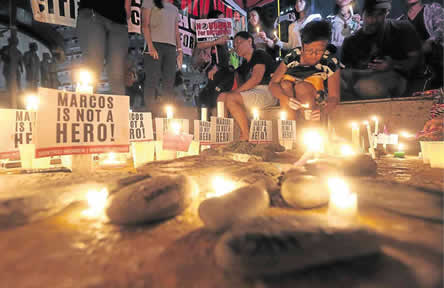
 t the book launching
of “Women Against Marcos: Stories of Filipino and Filipino American
Women Who Fought A Dictator” held at the Philippine Consulate in San
Francisco on April 1, a Balitang America reporter from The Filipino
Channel (TFC) mentioned that his assignment for the following day was a
Bongbong Marcos for Vice President rally in Sacramento where the
organizers were expecting more than a thousand supporters. This was
discouraging news to the 70 souls who came to hear the author, Mila De
Guzman, describe the inspiring stories of the brave Pinays who worked to
defeat the Marcos dictatorship. t the book launching
of “Women Against Marcos: Stories of Filipino and Filipino American
Women Who Fought A Dictator” held at the Philippine Consulate in San
Francisco on April 1, a Balitang America reporter from The Filipino
Channel (TFC) mentioned that his assignment for the following day was a
Bongbong Marcos for Vice President rally in Sacramento where the
organizers were expecting more than a thousand supporters. This was
discouraging news to the 70 souls who came to hear the author, Mila De
Guzman, describe the inspiring stories of the brave Pinays who worked to
defeat the Marcos dictatorship.
The book launch was a
reunion of veterans of the anti-martial law movement in the United
States. Cindy Domingo, one of the Pinays featured in the book, is the
sister of Silme Domingo, a member of the Union of Democratic Filipinos (KDP)
which organized the first Seattle protest against the Marcos
dictatorship in 1973.
SILME DOMINGO and
GENE VIERNES
Silme Domingo and his
fellow KDP activist, Gene Viernes, were active in their Local 37 union
and repeatedly clashed with the head of the union, Tony Baruso, who was
unabashedly pro-Marcos. On June 1, 1981, Domingo and Viernes were
gunned down and killed at the Local 37 office of the International
Longshoremen's and Warehousemen's Union (ILWU) by Pompeyo Guloy and
Jimmy Ramil who were arrested, charged and convicted of their murders.
On January 12, 1990, a
Los Angeles civil jury found Marcos and his supporters responsible for
ordering the murders of Domingo and Viernes. As reported in the New York
Times, the two supporters, Tony Baruso from Seattle and Dr. Leonilo
Malabed from San Francisco, were ordered to pay $8-M to the survivors of
Domingo and Viernes. The estate of Ferdinand Marcos and Imelda Marcos
were also found liable for running an intelligence network that spied on
anti-Marcos activists in the US. They were ordered to pay $15 million to
the families of Domingo and Viernes. Imelda Marcos later offered $2-M to
settle the case which was accepted by the court.
But news of the
Marcos-directed murders of Domingo and Viernes has not been generally
known in the Filipino American community.
ARCHIMEDES TRAJANO
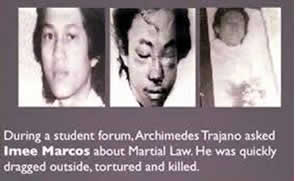 Neither
is the case of Trajano v. Marcos, a landmark 1992 federal appellate
decision (978 F.2d 493) that resulted from the 1986 civil suit filed by
Agapita Trajano, a resident of Hawaii, who sued Marcos and his daughter,
Imee Marcos-Manotoc, in 1986 for the abduction, torture and murder of
her son, Archimedes Trajano. Neither
is the case of Trajano v. Marcos, a landmark 1992 federal appellate
decision (978 F.2d 493) that resulted from the 1986 civil suit filed by
Agapita Trajano, a resident of Hawaii, who sued Marcos and his daughter,
Imee Marcos-Manotoc, in 1986 for the abduction, torture and murder of
her son, Archimedes Trajano.
These are the facts of
the case as described in the Ninth Circuit Court of Appeal decision: “In
August of 1977, Ferdinand Marcos was President of the Philippines,
Marcos-Manotoc was the National Chairman of the Kabataang Baranggay, and
Fabian Ver was in charge of military intelligence. Archimedes Trajano
was a student at the Mapua Institute of Technology. On the 31st of
August, Trajano went to an open forum discussion at which Marcos-Manotoc
was speaking. When Trajano asked a question about her appointment as
director of an organization, he was kidnapped, interrogated, and
tortured to death by military intelligence personnel who were acting
under Ver's direction, pursuant to martial law declared by Marcos, and
under the authority of Ver, Marcos, and Marcos-Manotoc. He was tortured
and murdered for his political beliefs and activities. Marcos-Manotoc
controlled the police and military intelligence personnel who tortured
and murdered Trajano, knew they were taking him to be tortured, and
caused Trajano's death.”
After a lengthy appeal
process, on October 21, 1992, the Ninth Circuit denied the appeal of
Imee Marcos-Manotoc, who claimed "sovereign immunity", and affirmed the
judgment against her awarding Agapita Trajano $1.25-M for mental anguish
and $2.5-M in punitive damages.
Archimedes Trajano was
just one of the 3,257 Filipinos who were tortured and killed during the
martial law regime according to an official UN report. This figure does
not include the thousands of Muslim civilians who were slaughtered in
the anti-Muslim military campaigns waged by Marcos in Mindanao. During
the 14 years of martial rule, the UN agency reports that there were at
least 35,000 documented instances of torture among the 70,000 Filipinos
who were incarcerated by Marcos, among whom were Sen. Benigno Aquino,
Jr., Sen. Jose Diokno and Sen. Soc Rodrigo.
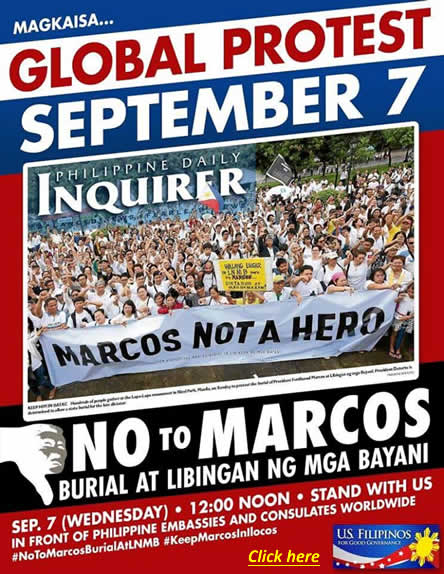
HUMAN RIGHTS
VICTIMS CLAIMS
Last year, about
46,985 martial law victims filed claims for reparation and recognition
before the Human Rights Victims' Claims Board (HRVCB) which was created
by law to distribute the P10 billion pesos that was transferred to the
government from a Swiss account holding a portion of the ill-gotten
wealth of the late president Ferdinand Marcos.
So how did the
namesake son of the man who was named by Guinness World Records as the
“biggest thief in history” and who fled the Philippines in disgrace in
1986 get to draw 14 million votes for vice president in the May 2016
vice presidential elections?
According to Dr.
Crispin Maslog, head of the Journalism Department of Silliman
University, this may be due to “martial law amnesia” which he does not
blame on today's millennials.
“We the older folks
are to blame. We did not teach them history properly – and I mean by we,
mainly the Philippine government and the mass media who suffered the
most under the Martial Law regime of Ferdinand Marcos. Now that the
surviving members of the Marcos family are active in politics again and
pushing a revisionist version of Martial Law history, we are worried, to
say the least,” Dr. Maslog wrote.
CRONYISM UNDER
MARTIAL LAW
Dr. Maslog disputes
the lie that the Philippine economy had its golden age during martial
law. He informs his students that in fact,“the Philippine economy took a
nosedive during the 14 years of Martial Law because of cronyism and
economic plunder. Cronyism was an economic system where every major
economic activity was controlled by the First Family, their relatives,
or cronies…Cronyism meant giving loans to friends that had little or no
collateral, whose corporations were undercapitalized. Marcos, family and
his cronies used the national coffers, the resources of private banks,
and even international loans from multinational banks for their
business. Aid money from the US and Japan were placed at the disposal of
Marcos’ money-making network. Until today we are still paying for these
loans squandered by the Marcos regime.”
Raissa Robles, the
author of “Marcos Martial Law: Never Again”, answers the question of how
the Marcoses rose from being thrown out of the country by People Power
in 1986 to now being “parked at the very doorstep of Malacañang, with
the dictator Ferdinand Marcos’ only son and namesake being groomed to
retake the Palace?”
Because “the Marcoses
never really left home.”
“The 1986 People Power
Revolution did chop down the Marcos political tree. But its intricate
roots that spread far and wide across the state bureaucracy and
Philippine society remained intact. All the Marcoses had to do was
nurture the roots and wait for the tree to grow back,” she wrote.
Imee Marcos candidly
explained her family’s secret to success: “Many professionals were
appointed by my father. So you have this immense bedrock of Marcos
appointees who keep moving up.”
MAINTAINING THE
DARK LEGACY
As Robles further
explained, “like secret stay-behind units, this vast army of
professionals scattered in all sectors of society have defended the
Marcoses and helped erase the dark legacy of their regime.”
After Marcos was
deposed in 1986, Robles explained, the government of President Corazon
Aquino “had to rely heavily on the bureaucracy that Marcos had built up
to institutionalize his tyranny. Enough key civil servants remained
closet Marcos loyalists or were sympathetic or deeply grateful to the
Marcos couple for acts of favor,” Robles wrote.
This was also this
extra element. Cory Aquino was a devout Catholic who wanted to be “the
opposite of Marcos.” Where Marcos jailed and executed his opponents,
Cory invited Imelda Marcos, a mother like her, to return home which she
did on November 4, 1991, “with no restriction to the pomp and pageantry
which accompanied it,” Robles observed.
“Imelda’s return
probably marks the start of the family’s slow but steady climb back to
power.”
BONGBONG ALMOST WON
That steady climb back
to power was stalled when Bongbong Marcos narrowly lost the
vice-presidency to a widow, Rep. Leni Robredo, ironically just as his
father lost the snap elections of February 1986 to another widow, Cory
Aquino. Bongbong’s loss may only be temporary as he has filed an
electoral protest and billions of pesos of Marcos hidden wealth may yet
change the Supreme Court outcome and put Bongbong one cardiac arrest
away from holding the title his father held for 20 years.
But Bongbong and his
family may have overplayed their hand. Rather than being content to have
their father’s remains kept in a refrigerated, glass-topped coffin
inside an air-conditioned crypt at the Marcos Mausoleum in his hometown
of Batac, Ilocos Norte where he is revered like a god, the Marcos family
has continuously pressed to have Marcos buried in the Libingan ng mga
Bayani (heroes’ cemetery).
The Marcos family’s
wish may finally come true. On August 11, Pres. Rodrigo Duterte, whose
father served as a Marcos cabinet secretary, finally acceded to the wish
of the Marcos family and ordered the burial of Ferdinand Marcos in the
Libingan, which had been set for September 18.
That single act of
hubris may yet prove to be the undoing of the carefully crafted return
of the Marcos dynasty to power.
THE FLOODGATES OF
PROTEST OPENED
Overnight, the
floodgates of protests against the Marcos burial opened. Despite heavy
rains, over 2,000 people gathered at the Luneta Park on August 14 under
a giant banner “Marcos is not a hero”. In attendance were Marcos-era
victims of torture and imprisonment as well as relatives of victims of
extrajudicial killings.
The following day,
many of these victims trooped to the Supreme Court to ask the Court to
stop the planned burial of Marcos. They cited a military regulation (AFP
G 161-373) which states that ''those who have been dishonorably
discharged from service, or personnel convicted of an offense involving
moral turpitude, do not qualify for interment."
The National Historical Commission of the Philippines (NHCP) issued
finding on August 11 that Marcos lied about receiving three military medals
and was never recognized as the leader of his supposed guerrilla unit,
Ang Mga Maharlika.
“A doubtful record
also does not serve as a sound, unassailable basis of historical
recognition of any sort, let alone burial in a site intended as its name
suggests for heroes,” the NHCP reported in its study. According to the
NHCP, Marcos’ military record is “fraught with myths, factual
inconsistencies and lies.
The petitioners also
argued that the law creating the heroes’ cemetery was “to perpetuate the
memory of all Presidents of the Philippines, national heroes and
patriots for the inspiration and emulation of this generation and of
generations still unborn." What is there to emulate from a plunderer?
''The interment of the
remains of Marcos at the LNMB with the honors that supposedly befit only
Filipino Heroes with overall unblemished integrity and dignity is
contrary to the Constitution,'' they said.
They also point out
that the Marcos family agreed in 1993, before they were allowed to
return to the Philippines, to bury the former leader in Ilocos Norte and
not in the Libingan ng mga Bayani. ''To abandon the agreement, reboot
the entire process, exhume his remains and allow his burial at LNMB is
to relive the terror and horrors of his victims who have, until now, not
been given justice. While his victims will be forgotten, Marcos will be
remembered as a president given a hero’s burial in violation of the law
and even their contractual commitment with the Philippine government,”
the petitioners said.
MARCOS VICTIMS CAN
NEVER REST
''This will not
achieve the purpose of closure espoused or accepted by others. While
Marcos rests in peace in LNMB, his victims who continue to cry out for
justice, can never rest in peace…The tyrant, dictator, and puppet must
stay where he is. Let us just let sleeping dogs lie," they added.
On August 24, the
Supreme Court issued a “status quo order” prohibiting the government
from burying Marcos in the Libingan for 20 days with oral arguments set
for August 31, which will be livestreamed on the Internet.
“It is not simply an
issue of burying Marcos. It is an issue of whether we allow to bury the
historical facts of the cruelties and atrocities committed by the Marcos
regime against its own people. We won’t allow distortions of our history
as a nation as we learned valuable lessons from the past to become a
great nation of the future,” John Monterona of United Overseas Filipinos
Worldwide.
GLOBAL PROTEST SET
FOR SEPT. 7
Meanwhile the Global
Kontra Libing Coalition has called for global protest rallies to be held
in front of Philippine Consulates all over the world on Wednesday,
September 7 at 12 noon to protest the burial of Marcos in the libingan.
Included as part of the protest will be symbolic coffins to represent
the thousands of people who were killed during martial law. Inside the
coffins will be stones marked with the names of the murdered victims.
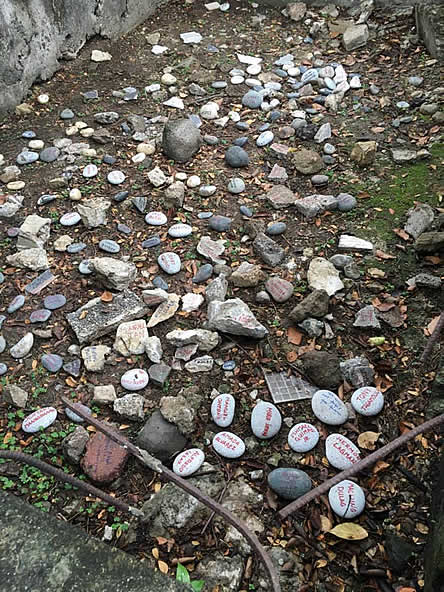
“Each stone represents a life. Each stone tells a story. We can each
place a stone,” is the request of the Bawat Bato conveners.
(Visit
Facebook page)
If the Marcos family
succeeds in their all-consuming ambition to bury Marcos in the heroes’
cemetery, the campaign to expose the truth about Marcos and martial law
will not end. It is expected that thousands of the families of victims
will pass by the grave of Marcos and leave a marked stone. One day,
Ilocos Norte Gov. Imee Marcos-Manotoc will clear the stones away from
her father’s grave and pick up one marked with the name “Archimedes
Trajano.” Will she even recall the day long ago when a young man asked
her a question at an open forum?
The Marcoses may yet
get their wish. But they may later wish they never did. Published 8/31/2016
(Send
comments to Rodel50@gmail.com or
mail them to the Law Offices of Rodel Rodis at 2429 Ocean Avenue, San
Francisco, CA 94127 or all 415.334.7800).
Sign the petition.
Click here.
Philippine President Rodrigo Duterte: NO to Burying Marcos in Heroes'
Cemetery.
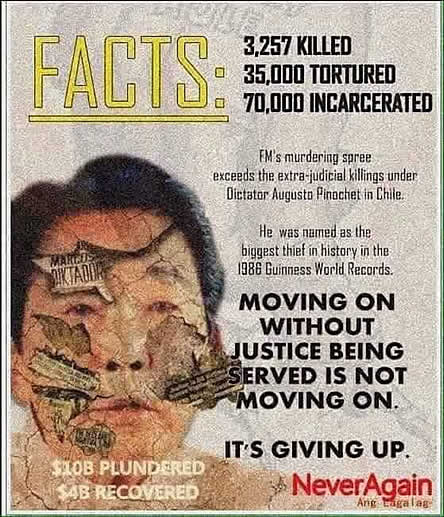 |